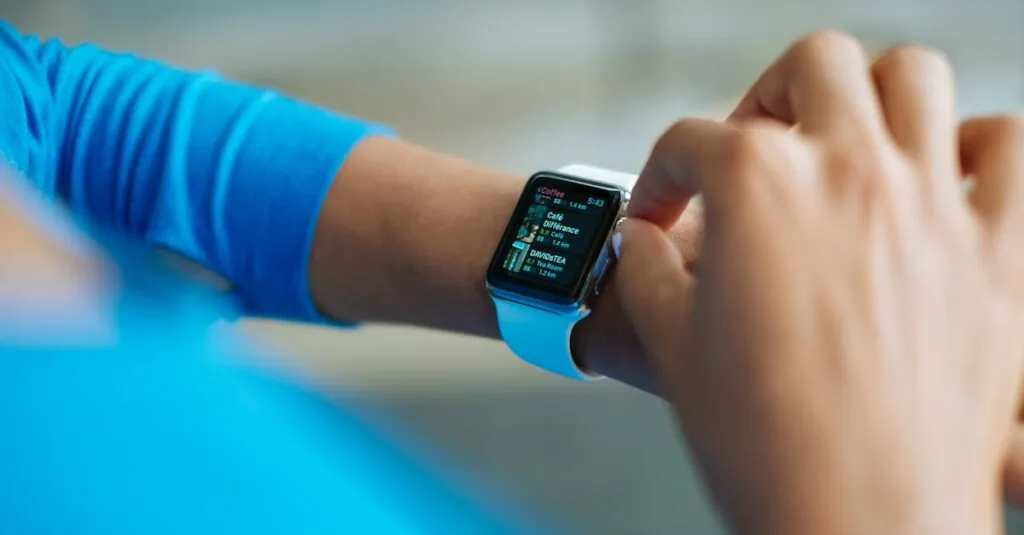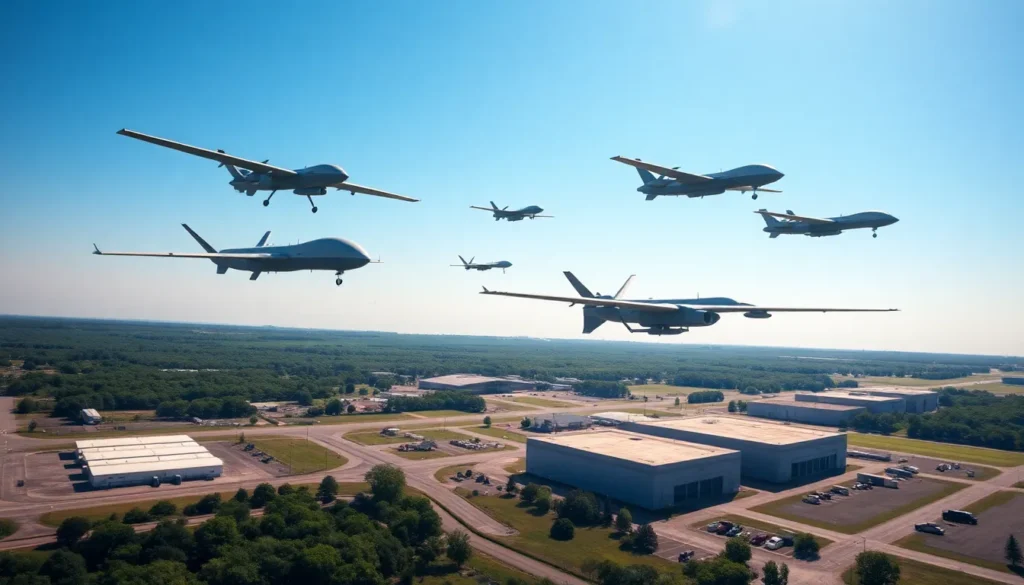In a world where flying robots are no longer just a sci-fi fantasy, swarm drones are taking center stage. Picture this: hundreds of tiny drones dancing through the sky like synchronized swimmers, all working together to accomplish tasks that would make even the busiest bee envious. These aerial marvels aren’t just for show; they’re revolutionizing industries from agriculture to disaster response.
Table of Contents
ToggleOverview Of Swarm Drones
Swarm drones operate through collective behavior, mimicking natural systems like flocks of birds or schools of fish. This technology allows multiple drones to coordinate activities autonomously, enhancing efficiency and effectiveness in tasks such as surveillance and monitoring. By using algorithms, swarm drones communicate and respond to their environment in real-time, adjusting their movements based on data received from nearby units.
Applications in agriculture include crop monitoring and pest control. Farmers utilize swarm drones to assess plant health and ensure optimal growth conditions. In addition, disaster response efforts benefit significantly from swarm drones. They can survey disaster sites quickly, delivering critical information to first responders while remaining agile in challenging scenarios.
Research indicates that swarm drones reduce operational costs by increasing mission success rates. They outperform single drones in various metrics, including coverage area and data collection speed. Security sectors also find value in swarm technology, employing it for tasks like border surveillance and large-event monitoring.
Developments in swarm drone technology continue to expand possibilities. Researchers focus on enhancing navigation capabilities and payload options while ensuring safety in crowded environments. Future advancements may enable swarm drones to tackle more complex tasks, streamlining operations across diverse fields. Increasingly, industries recognize the potential of this innovative technology, suggesting that swarm drones will play a pivotal role in the future of automation and robotics.
Technology Behind Swarm Drones
Swarm drones rely on advanced technology to perform tasks efficiently. This section examines key components essential to their operation.
Communication Systems
Swarm drones utilize robust communication systems for effective coordination. These systems enable drones to exchange information, enhancing their ability to respond collectively. Each drone shares data with nearby units, allowing real-time adjustments to their movements. Time-sensitive tasks benefit from this seamless communication. Low-latency protocols ensure that information transmits rapidly, minimizing delays during operations. Algorithms based on swarm intelligence facilitate decision-making among the drones. Applications in agriculture and surveillance highlight the importance of these systems, enabling a more dynamic response to changing environments.
Navigation Techniques
Drones navigate using sophisticated techniques that allow for precise positioning. GPS technology plays a crucial role in providing location data for each unit. Advanced sensors enhance environmental awareness, enabling drones to detect obstacles and adjust flight paths. Machine learning algorithms support autonomous navigation, allowing for improved path planning. Collective navigation ensures that drones move cohesively, mimicking natural swarms. Robust mapping techniques further contribute to their ability to cover extensive areas efficiently. Ultimately, these navigation advancements enable swarm drones to operate effectively in complex environments, supporting diverse applications across industries.
Applications Of Swarm Drones
Swarm drones are making significant impacts across various sectors. Their adaptability and efficiency offer numerous applications.
Military Uses
Military applications showcase swarm drones in tactical situations. These drones excel in surveillance and reconnaissance missions, enabling real-time intelligence gathering. They coordinate to overwhelm enemy defenses, enhancing offensive capabilities through collective action. Communication among drones ensures effective feedback loops during operations. Furthermore, swarm drones minimize risks to personnel while maximizing operational reach, making them a vital tool in modern warfare.
Commercial Uses
In the commercial sector, swarm drones revolutionize logistics and delivery systems. Companies utilize them to transport goods efficiently, covering large areas swiftly. These drones streamline warehouse operations by assisting with inventory management and monitoring. Additionally, the agriculture industry leverages swarm technology for precise crop spraying and monitoring health. Cost-effective solutions emerge as these drones reduce labor demands and enhance productivity, driving growth in various businesses.
Environmental Monitoring
Environmental monitoring benefits greatly from swarm drones’ capabilities. These drones collect critical data on air quality, wildlife populations, and ecosystem health. They can cover expansive areas quickly, enabling researchers to assess changes in habitats efficiently. Coordinated drone flights facilitate real-time responses to environmental threats, such as wildfires or pollution events. Enhanced data accuracy and timely reporting empower organizations to make informed conservation decisions.
Challenges And Limitations
Swarm drones face several challenges and limitations that affect their deployment and effectiveness.
Technical Challenges
Technical obstacles include communication issues within the swarm. Drones often depend on robust communication to operate cohesively, yet interference can disrupt signals. Navigation systems present another hurdle, particularly in complex environments where GPS signals may falter. Algorithms used for decision-making require extensive testing and fine-tuning to ensure reliability. Additionally, power consumption remains a concern, as maintaining battery life demands continuous innovation. Hardware limitations impact performance, particularly in handling payloads and maintaining stable flight. Addressing these obstacles is essential for enhancing swarm drone functionality.
Ethical Concerns
Ethical implications raise questions about privacy and surveillance when utilizing swarm drones. Mass data collection poses risks related to unauthorized monitoring of individuals. Accountability issues surface as determining responsibility for the actions of autonomous drones becomes complex. Furthermore, the potential for misuse in military applications generates significant debate. Balancing technological advancement with ethical considerations is vital as industries integrate swarm drone technology. Stakeholders must navigate these challenges to align drone operations with societal values.
Future Of Swarm Drones
Innovations in swarm drone technology promise significant advancements across various sectors. Automation in agriculture is set to become more precise as these drones evolve. Advancements will enhance capabilities for crop monitoring and pest control, enabling farmers to optimize yields more effectively.
Military applications also stand to benefit. Enhanced coordination among swarm drones can improve reconnaissance missions, allowing for safer and more efficient data collection. This collective approach reduces risks to personnel while gathering critical information in real time.
Commercial logistics showcase another promising area. Swarm drones can streamline delivery processes, particularly in urban settings, by coordinating their routes to minimize congestion and maximize delivery speed. Innovations can transform warehouse operations, enabling quicker inventory management and more efficient order fulfillment.
Research consistently shows that swarm drones outperform single units in various metrics, including coverage area and data collection speed. This trend indicates a growing reliance on swarm technology for tasks requiring rapid response and comprehensive monitoring.
Technical challenges persist, though. Communication issues within the swarm can hinder performance, while navigation difficulties may arise in dense urban environments. Addressing these barriers will be essential to unlock the full potential of swarm drones.
Ethical implications must also be considered as technology continues to evolve. Privacy and accountability concerns regarding drone usage necessitate careful regulatory frameworks. Striking a balance between innovation and ethical practices ensures the responsible integration of swarm drones into everyday life.
Developments in artificial intelligence further fuel advancements, allowing swarm drones to learn from their environments. Continuous improvements in algorithms will support more adaptive and efficient responses in a variety of settings. The future paints a picture of swarm drones that not only elevate industry standards but also reshape the landscape of automation and robotics.
Swarm drones are revolutionizing various industries with their ability to operate collaboratively and efficiently. Their applications in agriculture, disaster response, and military operations illustrate their transformative potential. As technology advances, these drones will tackle increasingly complex tasks, enhancing productivity and safety.
However, challenges such as communication hurdles and ethical considerations must be addressed to ensure responsible integration. The future of swarm drones looks promising, with ongoing innovations set to redefine automation and robotics. Stakeholders must navigate the balance between technological progress and societal values to fully harness the benefits of this groundbreaking technology.





